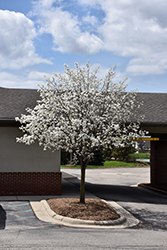It's all about ...
plants

Height: 45 feet
Spread: 30 feet
Sunlight:
![]()
Hardiness Zone: 6a
Other Names: Bradford Pear
Description:
A popular feature tree, covered in a cloud of white flowers in spring followed by small inedible fruit; superb fall color and a broadly handsome oval shape; very ornamental, but short lived with weak branches; considered invasive in some southern areas
Ornamental Features
Callery Ornamental Pear is bathed in stunning clusters of white flowers along the branches in early spring before the leaves. It has dark green deciduous foliage. The glossy heart-shaped leaves turn outstanding shades of yellow, gold and dark red in the fall. However, the fruit can be messy in the landscape and may require occasional clean-up.
Landscape Attributes
Callery Ornamental Pear is a dense deciduous tree with a shapely oval form. Its average texture blends into the landscape, but can be balanced by one or two finer or coarser trees or shrubs for an effective composition.
This is a high maintenance tree that will require regular care and upkeep, and is best pruned in late winter once the threat of extreme cold has passed. Gardeners should be aware of the following characteristic(s) that may warrant special consideration;
- Messy
- Invasive
Callery Ornamental Pear is recommended for the following landscape applications;
- Accent
- Shade
- Vertical Accent
Planting & Growing
Callery Ornamental Pear will grow to be about 45 feet tall at maturity, with a spread of 30 feet. It has a low canopy with a typical clearance of 5 feet from the ground, and should not be planted underneath power lines. It grows at a fast rate, and under ideal conditions can be expected to live for approximately 20 years.
This tree should only be grown in full sunlight. It prefers to grow in average to moist conditions, and shouldn't be allowed to dry out. This plant will benefit from an application of bonemeal and/or mycorrhizal fertilizer at the time of planting. It is not particular as to soil type or pH. It is highly tolerant of urban pollution and will even thrive in inner city environments. This species is not originally from North America.
This plant is not reliably hardy in our region, and certain restrictions may apply; contact the store for more information.
